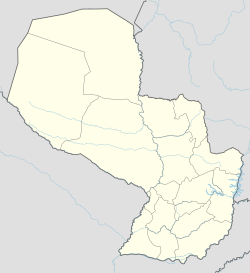Pilar, Paraguay
| Pilar | |||
|---|---|---|---|
| City | |||

The Cathedral
|
|||
|
|||
| Coordinates: 26°52′12″S 58°18′0″W / 26.87000°S 58.30000°WCoordinates: 26°52′12″S 58°18′0″W / 26.87000°S 58.30000°W | |||
| Country |
|
||
| Department | Ñeembucú | ||
| Foundation | October 12, 1779 | ||
| Government | |||
| • Intendente Municipal | Carlos Francisco Silva Medina. | ||
| Area | |||
| • Total | 1,130 km2 (440 sq mi) | ||
| Population (2008) | |||
| • Total | 28,716 | ||
| • Density | 25/km2 (66/sq mi) | ||
| Time zone | AST (UTC-04) | ||
| • Summer (DST) | ADT (UTC-03) | ||
| Postal code | 2800 | ||
| Area code(s) | (595)(86) | ||
Pilar is the capital city of the Paraguayan department of Ñeembucú, located along the Paraguay River in the southwestern part of the country. Located about 358 km (222 mi) from Asunción, Pilar serves as an important center of commerce and government for the far southwestern region of the country.
Pilar was founded by Pedro Melo de Portugal on October 12, 1779. The original name of the settlement was Villa del Ñeembucú, named for the nearby Arroyo Ñeembucú that flows into the Paraguay River. Four years later it was renamed Villa del Pilar by Spanish priest Marcial Antonio Uliambre, for the Basilica of Our Lady of the Pillar (Spanish: Catedral-Basílica de Nuestra Señora del Pilar) in his hometown of Zaragoza.
The old town council building in Pilar is where former president Francisco Solano López is believed to have uttered a now famous phrase in defiance against combatants in the costly Paraguayan War : "Never shall the sacred insignia of my country fall from my hands".
Situated near the confluence of the Paraguay and Paraná rivers, Pilar is in a region of the country with many small streams, rivers and wetlands that contribute to a humid climate. The average annual temperature is 22 °C (72 °F). Summer temperatures can reach as high as 40 °C (104 °F), and it winter it drops to as low as 2 °C (36 °F). The rainy months are January, March, April and October; the dryer are May and August. The Köppen Climate Classification subtype for this climate is "Cfa" (Humid Subtropical Climate).
...
Wikipedia



